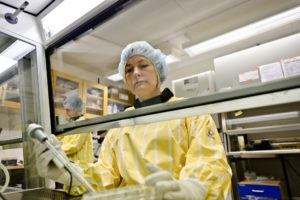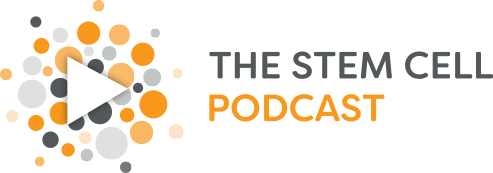https://youtu.be/V8tR1zEf1Sc

Malin Parmar
We are on a short break from our audio podcast; however we are delivering written laboratory features in lieu of audio interviews during this short break here on our blog.
This Featured Lab post is brought to you by STEMCELL Technologies. STEMCELL Technologies knows that figuring out what to use when working with hPSCs can be difficult, especially for new people. They have made some interesting and fun infographics to help sort it all out. You can access these infographics at www.stemcell.com/goPSC.
Dr. Malin Parmar is a professor at the Wallenberg Neuroscience Center and Lund Stem Cell Center at Lund University in Lund, Sweden. Her group is involved in working with translational stem cell biology where they seek to understand the specification of a cell’s fate in the developing brain as well as in the neural progenitor cells of humans through the use of neuronal differentiation cell-based models.
Focus on Developmental and Regenerative Neurobiology
Dr. Malin Parmar and her team are directing their focus on the discovery of direct and efficient techniques to drive the controlled differentiation of human stem cells into neurons of specific subtypes. In addition, they are also developing technologies capable of directly converting human fibroblasts into neurons that are functional and subtype-specific in vitro, as well as converting endogenous glia into neurons in vivo.
Ultimately, the team seeks to achieve the development of these cells and technologies which may be useful for brain repair, specifically focusing on Parkinson’s disease.
Latest Findings
- Developing human dopamine nerve cells for clinical translation
The group is focused on the development of cell replacement therapy in Parkinson’s disease. At present, they are developing GMP compliant protocols through t NeuroStemCellRepair, a network funded by the EU.
The team is also conducting an extensive preclinical validation of the human dopamine neurons based on their protocol in rat models of Parkinson’s disease including the assessment of cell fate through the extended survival of transplanted cells in vivo, the assessment of function and behavior of graft function in vivo, as well as their maturation and integration.
Moreover, the team, being a member of the European clinical trial TRANSEURO, also conducts a preclinical validation of dopamine neurons in human fetus to be used clinically. Consequently, this brings about opportunity for the team to compare their hESC-derived dopamine nerve cells directly with those cells derived from the tissue of human fetus both in vitro and in vivo.
- New methodologies in the in vivo assessment of human nerve cells generated from stem cells or through reprogramming
Dr. Parmar and her team basically monitor their cells after transplantation through the use of a number of standard in vivo assessments. Considering the increase of new cell sources such as stem cells and reprogrammed cells, the development of new methodologies now becomes critical in order to achieve a more comprehensive assessment of human neurons that have been produced using the said techniques. As a result, they have recently generated several new advancements in order to determine the function and integration of transplants with the host brain.
With the use of the monosynaptic tracing approach, specifically utilizing modified rabies vectors, the team is able to visualize synaptic contacts that have been generated between the host nerve cells and the grafted human cells, giving way to the possibility of being able to investigate graft integration in vivo which is unfortunately not given any attention in the field today.
In order to increase their understanding of graft integration, the team as well tries to determine how this functionally happens through the use of optogenetics combined with methods that are highly sensitive and quantitative in nature, and which assess the function of the nerve cells including in vivo amperometry and electrophysiology.
- Human fibroblasts directly converted into functional neurons that are sub-type specific
One of the lab’s studies demonstrated that the use of a defined sets of transcription factors could directly convert human fibroblasts into functional and subtype-specific nerve cells called induced neurons (iNs) which provide shorter route than induced pluripotent stem cells (iPSCs) in terms of producing nerve cells that are specific to the patient and disease.
At present, the team seeks to increase the production and enhance the ability to transplant directly programmed dopamine neurons as well as develop certain reprogramming techniques which are clinically compatible.
- Converting neurons in vivo
Dr. Malin Parmar and her team has recently demonstrated the potential conversion of endogenuos mouse astrocytes into neurons in situ. This was made possible by using a transgenic mouse model to particularly manipulate reprogramming genes into parenchymal astrocytes that reside in the striatum. Consequently, this study supports the principle that the neurons of endogenous glia can be directly converted in the adult brain of a rodent.
Currently, the group seeks to achieve the following: determine the optimal starting cell population for neural conversion; identify what gene combinations can generate subtype specificity; and asses how reprogrammed neurons function and integrate.
- The development of the human midbrain
Dr. Parmar’s team has recently illustrated a number of key transcription factors that impact the dopamine neuron specification in the rodent brain are apparently expressed in homogeneous areas of spatio-temporal expression during the development of the human midbrain. Additionally, the study suggests that the radial glia cells found in the floor plate actually generate DA neurons in the human brain.
As part of their research efforts, the team is continually mapping the dopamine domain during the development of human fetus as well as investigating the location of serotonergic neurons and their corresponding precursors in the adjacent regions of the hindbrain.
- Molecular factors that control the development of the human brain
Dr. Parmar and her team are determined to investigate various pathways that control how the human developing brain is regionalized and specified through analyzing the anatomy of fetal brain as well as identifying key genes and noncoding RNAs that control how the human brain is compartmentalized. The team further seeks to study the consequences of new genes on neural differentiation by using human embryonic stem cells (hESCs) to simulate brain development towards different regions of the human brain.
Additionally, the team is also involved in a creative environment at Lund University working on more advanced 3D culturing methods that model the development of human brain using anatomically based hESCs. They have applied state-of-the-art microfluidic techniques in culturing hESCs that have been stimulated by chemical gradients in order to model the environment around the developing fetal brain. As a result, neural tissues are produced that have anatomical characteristics that resemble the developing human brain.
Please leave a comment below with any questions you have for Dr.Parmar or any other labs you would like to see us feature.
The Stem Cell Podcast Team
The #1 Resource for All Things Stem Cells

